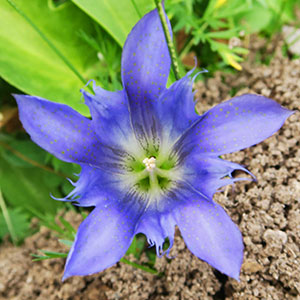Gentiana newberryi
Gentiana andrewsii
alpine gentian, Newberry's gentian
Andrew's bottle gentian, bottle or fringe bottle or prairie closed gentian, closed bottle gentian
1–5, arising laterally below rosettes, from a stout tap root, tufted, decumbent.
1–20, terminal from caudex, decumbent to erect.
basal and cauline;
blades of basal rosette and proximal cauline leaf blades widely spatulate to obovate or oblanceolate, 0.8–5 cm × 2–25 mm, apex obtuse or mucronate, at least these leaves with blades less than 6 times as long as wide, distal cauline leaves few, with blades oblanceolate to lanceolate or linear, 2–5 cm × 2–5 mm, apices acute.
cauline, ± evenly spaced;
blade elliptic-oblong to lanceolate or narrowly ovate, 3–16 cm × 10–50 mm, apex acuminate.
terminal, flowers usually solitary, occasionally 2 or 3.
1–25-flowered heads, often with additional flowers at 1–6(–9) nodes or on short branches.
calyx 14–30 mm, lobes linear to narrowly ovate, (4–)6–12 mm, margins not ciliate;
corolla white or blue, campanulate, open, 23–55 mm, lobes spreading, elliptic-obovate, 7–17 mm, free portions of plicae divided into 2 triangular, serrate to lacerate segments;
anthers distinct.
calyx 9–29 mm, lobes lanceolate to ovate or occasionally oblanceolate, 2–15 mm, margins ciliate;
corolla blue, white, or rarely rose-violet, tubular, completely closed, 28–45 mm, lobes reduced to a mucro or ± triangular, 0.5–2(–3) mm, free portions of plicae oblong, shallowly and nearly symmetrically bifid, summit truncate, erose;
anthers connate.
winged.
winged.
Gentiana newberryi
Gentiana andrewsii
Varieties 2 (2 in the flora).
The two varieties of Gentiana newberryi intergrade extensively. The most distinctive form of var. newberryi, with relatively tall stems and medium to deep blue corollas, occurs in the northern part of the range of the species, from the Klamath and White mountains of California north into Oregon. Plants most clearly referable to var. tiogana prevail in the southern part of the range of the species, from Butte County south to Inyo and Tulare counties, California. In the central part of the range of the species, plant size and corolla color are less consistently correlated, with occasional plants combining low stature with deep blue corollas or tall stems with predominantly white or pale blue corollas. In that part of the range, corolla color may be highly variable within a single population.
The leaves of Gentiana newberryi are thick-textured and distinctively concave, usually spoon-shaped, when fresh. Narrower leaves sometimes occur in var. tiogana, but many plants of that variety have widely spatulate leaves like those of var. newberryi.
(Discussion copyrighted by Flora of North America; reprinted with permission.)
Varieties 2 (2 in the flora).
Gentiana andrewsii is the only species of Gentiana in which the plicae of the corolla are distinctly longer than the lobes.
Gentiana andrewsii has often been reported outside its actual range. Although the epithets of some of the species that have been confused with or considered inseparable from G. andrewsii have priority, the familiar name G. andrewsii is often misapplied, sometimes because it is assumed that any “closed gentian” is G. andrewsii. As G. clausa was not distinguished from G. andrewsii in standard floras prior to 1950, reports from the northeastern United States based on specimens identified before 1950 should be considered doubtful if the specimens have not been reexamined. Old reports from the southern Appalachians are also questionable because G. austromontana was not recognized until 1964. Some reports from the southeastern and south-central United States and along the Atlantic seaboard have been based on specimens of G. saponaria. True G. andrewsii is distinguishable as the only Gentiana species in which the corolla plicae distinctly exceed the minute lobes. The fringed tip of the completely closed corolla, at first white, soon turning reddish brown, is an excellent field mark for distinguishing G. andrewsii from G. clausa. In G. clausa, the summit of the intact corolla appears completely blue (in the typical color form), and the plicae are concealed. Gentiana andrewsii grows in calcareous soils and G. clausa in noncalcareous soils.
Because of this ecological separation, there are only a few records of hybridization between Gentiana andrewsii and G. clausa. In the tall-grass prairies, G. andrewsii hybridizes with G. flavida, producing G. × pallidocyanea J. S. Pringle, and with G. puberulenta, producing G. × billingtonii Farwell (as species). Northward, it occasionally hybridizes with G. rubricaulis, producing G. × grandilacustris J. S. Pringle, and in the southeastern part of its range it hybridizes with G. saponaria.
(Discussion copyrighted by Flora of North America; reprinted with permission.)
1. Corollas medium to deep blue with greenish to dark purple lines abaxially on and below lobes, usually 35–55 mm. | var. newberryi |
1. Corollas white to pale blue except for greenish to dark purple lines abaxially on and below lobes, usually 23–42 mm. | var. tiogana |
1. Corolla lobes reduced to a mucro or at most minutely triangular, less than 1 mm. | var. andrewsii |
1. Corolla lobes triangular or ± rounded, 1–2(–3) mm. | var. dakotica |


